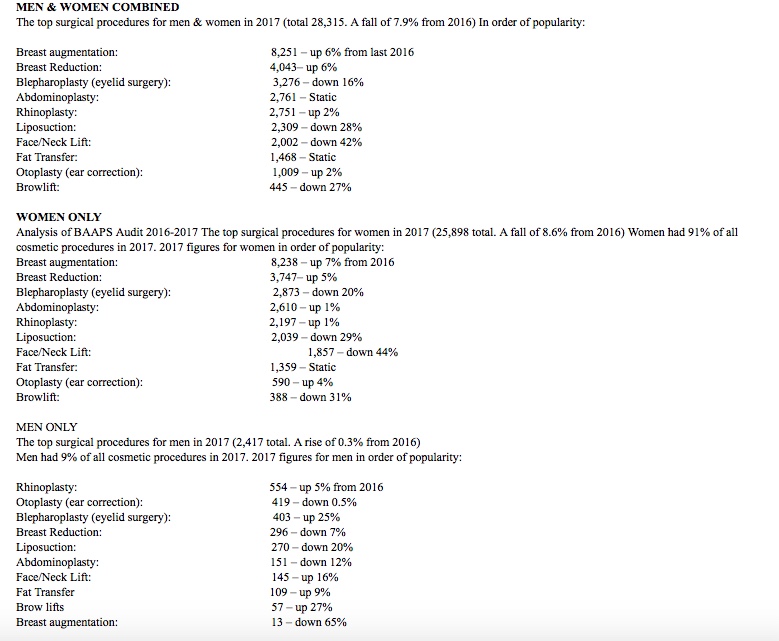Annual BAAPS audit reveals gender divide in surgery preferences
 New data released by the British Association of Aesthetic Plastic Surgeons as part of its annual members audit has revealed a surprising yet clear-cut trend in aesthetic procedures, uncovering a new gender divide.
New data released by the British Association of Aesthetic Plastic Surgeons as part of its annual members audit has revealed a surprising yet clear-cut trend in aesthetic procedures, uncovering a new gender divide.
As expected, surgical procedures as a whole are still slightly declining overall (only just, under 8%), now that there are so many less invasive enhancement options to explore. But the most interesting shift, surgeons say, is in how strongly divergent the trends are between the sexes.
Men in 2017 eschewed almost all forms of body treatment – with procedures such as liposuction (down 20%), tummy tucks (down 12%) and even ‘man boobs’ (gynaecomastia, down 7%) all but abandoned, in favour of a marked predilection for facial procedures instead, such as eyelid and brow lifts surgery (up by an eye-watering 25% and 27%) and facelifts (up 16%).
Conversely, women’s choices were mainly focused on the body alone, shunning most, if not all, facial treatments – with the number of female facelifts declining by as much as a whopping 44% and brow lifts drooping by 31%– yet, still, breast augmentation perked up by 7% and remains the most popular procedure.
The BAAPS; which represents the vast majority of NHS-trained consultant plastic surgeons in private practice; ascribe this surprising change as indicative of changing societal trends. According to consultant plastic surgeon and former BAAPS President Rajiv Grover, who compiles the audit on an annual basis, “For men, the media’s adoption and celebration of the more natural looking ‘dad bod’ is possibly a driver in this interesting trend, shifting the focus to the face rather than the body, in contrast to recent years - a shift that has lessened the pressure to sport a sculpted figure and instead, accept a bit of roundness or softness. Society unfortunately has a history of being more forgiving towards men’s physiques than women’s.
Millennials are expected to take as many as 25,000 selfies in their lifetime and more than half of women admit to enhancing every photo they ever post. Grover continues, “The advent of myriad filters in social media platforms allows for the ubiquitous enhancing and facial feminising of ‘selfies’. However there are fewer options to reach online ‘fitspiration’ when it comes to body goals.
"It is possible that fashion may also play a part; for example the growing trend of activewear such as yoga pants and Lycra leggings being worn in everyday life; perhaps demanding a more toned shape.
“Both of these factors may potentially be the reasons why women’s focus for cosmetic surgery in 2017 has shifted from their face to their body in order to address the stubborn areas that neither diet, exercise, nor filters can reach.”
It is also known that women prefer and post more portrait photos with direct eye contact, while men prefer more full body shots - but viewers are likely to be kinder to men. Grpver says, “Data from the 2017 BAAPS Annual Audit shows that the number of Britons undergoing cosmetic surgery is slightly decreasing - down 7.9% in 2017 from the previous year. In particular, traditional liposuction is radically down across both genders (28% decrease), which we usually credit to the ‘cooling effect’ of new non-surgical procedures such as fat freezing. However, abdominoplasties (tummy tucks) are up – indeed increasing from 6th to 4th most popular procedure – as there are no less invasive options capable of achieving significant results to eliminate excess skin.”
According to BAAPS President and consultant plastic surgeon Simon Withey, the slight downturn in cosmetic surgery procedures demonstrates a ‘normalisation’ as the British public are now more aware about the serious impact of surgical procedures, “The 2017 BAAPS audit offers valuable new insights into the extent that Britons online personas may be driving offline behaviours. The slight downwards shift in surgical procedures overall hopefully continues to demonstrate that at the very least, patients are realising that cosmetic surgery is not a ‘quick fix’ but a serious commitment.
“Although there may be some new non-surgical options for cosmetic treatments, it is important to remember that ‘non-surgical’ does not mean ‘non-medical’, and patients should be wary of anything touted which seems too good, or too cheap, to be true. The climate of lax regulation has yet to be addressed in a satisfactory manner to protect the public.”

References
[2] https://www.aol.com/article/ne
--

